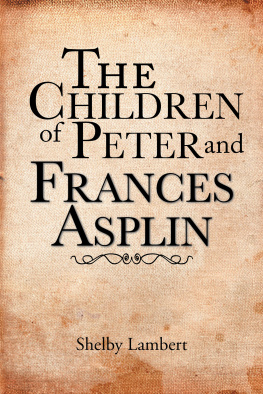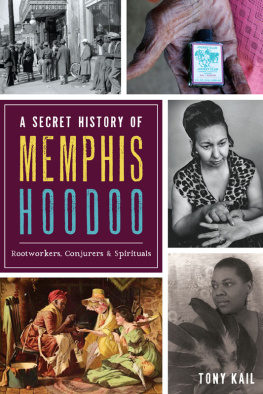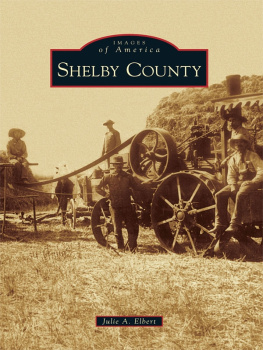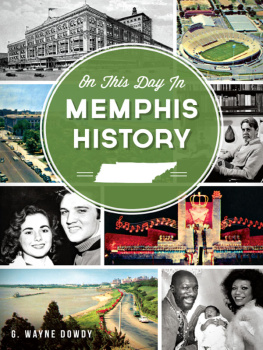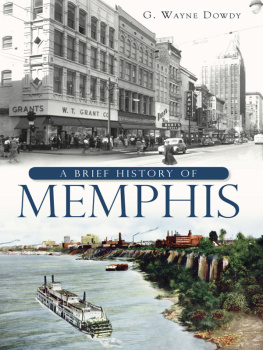ACKNOWLEDGEMENTS
Id like to thank the helpful staff of the Memphis and Shelby County Room at the Memphis Public Library and Information Center, especially G. Wayne Dowdy, an underappreciated Memphis treasure and inexhaustible font of knowledge. Id also like to thank Shekinah Toebbe, who helped track down many of this books historical photos.
Fourteen years ago, I was fortunate enough to be able to turn from one passion, the practice of law, to another, Memphis history, and start a tour company, Backbeat Tours. At Backbeat Im grateful to have a staff of talented people, especially the irreplaceable Megan May, who bring these Memphis stories to life and inspire me every day. Finally, Id like to thank my wife, Deborah: without her love and support, this book would not be possible.
INTRODUCTION
On a drizzly day in early April 1819, two men rode on the top of a flatboat down the Mississippi River and watched the thick, lush vegetation of the banks roll by. The land was densely wooded and otherwise featureless, until a line of bluffs appeared on the eastern bank. The boats pilot, an experienced riverman who had made this trip numerous times before, steered close to shore, caught the eddy at the foot of the bluff and drifted into a wide marshy stream that entered the larger river. Planks were laid over the mud to higher, firmer ground, and the passengers clambered ashore. They walked to the top of a rise and took stock of their surroundings: a few houses, crudely built on the edge of the bluff overlooking the river, and in the distance, the remains of a blockhouse. And there were trees, lots of trees.
The men were actually looking for trees, or rather for one particular tree: a large white oak with the initials JR carved into the trunk. The tree marked the corner of a five-thousand-acre tract once owned by a North Carolina speculator named John Rice. The menWilliam Lawrence and Marcus Winchester, agents for the tracts current ownerswere here to survey the property and stake out streets and lots of a new town.
Rice had been killed by Indians nearly thirty years earlier, and his heirs sold the claim for $500 to a young Nashville attorney, John Overton. Overton shared the tract with his good friend, Andrew Jackson, and three years later, Jackson in turn shared his interest with another friend, Revolutionary War veteran General James Winchester. With the price of cotton rising and land on the frontier being rapidly developed, they believed there was money to be made by planting a city on the Mississippi bluffs. Overton, Jackson and Winchester were optimistic about the success of their venture and were sure that their city would be one of the most important on the Mississippi. Looking upon the mighty river as the American Nile, they continued the Egyptian motif and named the city Memphis, after the Egyptian Old Kingdom city of pharaohs at the mouth of the Nile delta.
Sketch by Charles Alexandre Leseur of the Memphis waterfront in April 1828. Courtesy of Memphis and Shelby County Room, Memphis Public Library and Information Center.
There was just one problem: they didnt actually own the land at all. Legally, it still belonged to the Chickasaw Nation.
Not ones to let a technicality stand in the way of making money, the trio of proprietors, through friends in the Tennessee legislature, lobbied Congress to procure a relinquishment of the Chickasaw claim. Congress quickly appointed a commission to negotiate with the Chickasaw. The commissioners, to no ones surprise, were former Kentucky governor Isaac Shelby and Andrew Jackson. That Jackson stood to gain an enormous personal profit from any resulting treaty seemed not to be a matter of concern to anyone.
On the way to the treaty ground, Jackson and Shelby had agreed to go no higher than $300,000; Shelby even thought half that would do. The Chickasaws, for their part, proved to be no pushoversthey had previous experience negotiating with the U.S. government, and with Andrew Jackson in particularand after nearly two weeks the bidding reached as high as $280,000, payable in fourteen annual installments of $20,000. On the verge of an agreement, the Chickasaws asked for one more cent. America was so strong and rich, they argued, what was one more cent? Jackson asked if that would do it, and the Chickasaws said yes. The commissioners agreed, and everyone shook hands all around, only to find out a bit later from the interpreters that what the Chickasaws meant by one more cent was an additional $20,000 installment payment. Jackson, desperate for a treaty, readily agreed, but Shelby was furious and flatly refused. The two argued bitterly and almost came to blows. Jackson threatened to sign the treaty himself and send it to Washington for ratification and then added that, if the fifteenth annual payment of $20,000 was the issue, he would sign a bond and promise to pay it personally. Though he still had misgivings, Shelby relented, and the Chickasaw Cession was signed on October 19, 1818.
On the bluffs the following spring, the two surveyors, Lawrence and General Winchesters son, Marcus, hurried to finish their task. Ratification of the treaty had sparked a land rush, and other surveyors were staking claims in the area, too. As Overton wrote, If the country settles as fast as I think it willwe must not let the owners of property on the Bluffs of the Mississippi above us be beforehand in laying off towns, as it might damp the sale of ours.
Overtons town plan was fairly enlightened for its day, with broad streets, four public squares and a spacious promenade along the top of the bluff down the entire length of the riverfront. Still, it faced substantial opposition from squatters and Indian agents who had been living here, some of them for over twenty years, since the time of the Spanish. To ease tensions and start their venture on a positive note, the proprietors decided to donate lots to the existing residents.
On May 22, 1819, Lawrence and Marcus Winchester called everyone together to formally announce the proprietors plans, convey lots in the new town and issue temporary certificates of title. The first lot, no. 53, at the southeast corner of Winchester and Front Streets, was given to Benjamin Foy, a magistrate under the Spanish who, though he had moved across the river, was still influential and greatly respected on the bluffs. The second lot, on Front Street at the south side of the alley between Concord and Overton Streets, was given to the widow Peggy Grace, who had come some years before with her husband and settled just north of the Gayoso Bayou; her lot would in a few years be the site of one of the citys first taverns. Thomas Carr, who had been passing through the previous fall with his brother Anderson when he heard news of the treaty and decided to stay, was granted two swampy acres on Main Street on condition that he drain the land, build a mill and a blacksmiths shop in one year and a cotton gin in two years. Various other conveyances were made, and Marcus Winchester served out plenty of whiskey shipped in by flatboat for the occasion.







